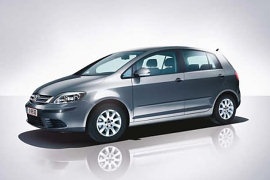
VOLKSWAGEN Golf Plus
Generations Timeline, Specs and Pictures

Volkswagen didn’t want to completely lose the segment of the compact-sized SUV segment and introduced a Golf-based family MPV in 2004.
It was refreshed in 2008, after the introduction of the Golf MkIV.
In 2008, the sixth generation of the Golf was introduced in October at the Paris Motor Show. Two months later, the Golf Plus received a face similar to the famous Volkswagen compact car. It was a needed refresh for a car that struggled in a market that was shrinking.
The front fascia featured similar headlights and grille with the Golf 6, but the taillights were similar to the 5th generation. The roof-rails were fitted as standard for most of the range. A new design for the wheels and the modified front bumper improved the car’s look.
With its higher greenhouse, the Plus version allowed a higher seating position inside and still offered enough headroom. The legroom was improved as well so all the five passengers could sit comfortably inside. Most of the interior was similar to the Golf 5, including the instrument panel, centers stack, and controls.
The engine range was improved with the addition of the newly developed 1.6-liter turbodiesel engine range. A newer 2.0-TDI unit and improved gasoline engines were added to the list. The car was fitted with a choice of manual or automatic gearboxes, depending on the engine. Since the car was based on the Golf 5, it featured independent suspension an all corners, which added comfort for its passengers.

Volkswagen tried to get a slice from the European compact minivan market and introduced the Golf Plus in 2004.
While Renault was gaining with the Megane Scenic (latter named only as Scenic), Volkswagen had nothing to show on the compact minivan segment. Its engineers rushed and used the Golf MKV’s platform (PQ35) and made the Golf Plus. A minivan with a higher seating position and better headroom than the regular Golf.
The German carmaker used the name Golf for the Plus to get more attention from the public, and it shared its underpinning with its brother, but the exterior look was not on the same page. It featured a steep front fascia with a body-colored grille and two slats. Its headlights featured a sharp angle on the inner side and extended around the corners onto the front fenders. Its bumper sported a grille at the bottom and, as an option, two fog lights on the sides. Since it was 95 mm (3.7”) taller than its sibling, the Plus needed a steeper windshield too. In the back, the tailgate and the taillights resembled those from the regular, Golf.
Inside, the seats were mounted higher by 75 mm (2.9”), resulting in more legroom for the rear-seat passengers. Thus, the Plus was more comfortable for five adults, even on the long roads. The dashboard four air vents on the center stack and two more twin vents on the outer sides of the dash panel. Another essential aspect was the trunk size, which provided up to 1,450 liters (51.2 cu-ft) of space with folded rear seats.
Under the hood, Volkswagen installed a wide engine choice for the Golf Plus. It started with a 75 hp, 1.4-liter gasoline engine and ended up with a 2.0-liter, 150 hp unit. There were three turbo-diesel versions ranged between 90 hp and 140 hp.























































